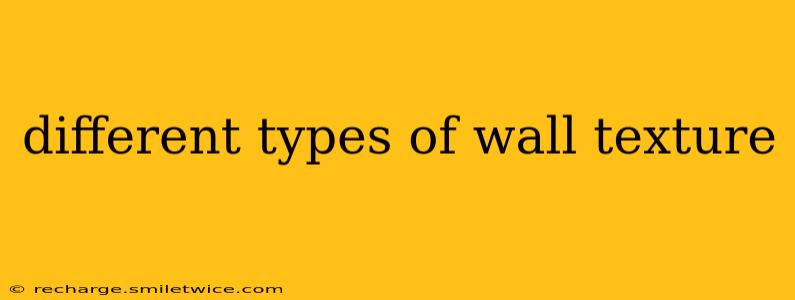Choosing the right wall texture can dramatically impact the look and feel of your space. From subtle elegance to bold statements, the options are vast. This comprehensive guide explores various wall texture types, their characteristics, and ideal applications, helping you make an informed decision for your next project.
What are the Different Types of Wall Textures?
Wall textures are created using a variety of materials and techniques, resulting in a wide range of finishes. Here are some of the most popular types:
1. Smooth Texture
This classic finish offers a clean, minimalist aesthetic. Smooth walls are easy to clean and maintain, making them a popular choice for kitchens, bathrooms, and high-traffic areas. However, imperfections in the underlying wall surface are more visible with a smooth finish. Painting smooth walls can also highlight any irregularities.
2. Orange Peel Texture
This popular texture is named for its resemblance to the skin of an orange. It's relatively fine, offering a slightly bumpy surface that subtly masks minor wall imperfections. Orange peel texture is relatively easy to paint and maintain.
3. Knockdown Texture
Also known as "popcorn texture" (though technically different), knockdown texture features a heavier, more pronounced texture than orange peel. It's applied thickly and then scraped down, leaving a somewhat rough, uneven surface. Knockdown texture is excellent for hiding wall imperfections but can be more challenging to clean and repaint.
4. Sand Texture
This texture is created by applying a mixture of sand and plaster to the wall. The resulting finish is coarse and gritty, offering a rustic or beachy feel. Sand texture is durable and hides imperfections well, but it can be difficult to clean.
5. Stipple Texture
Stipple texture is created using a stippling brush or roller to create a speckled effect. This texture adds a subtle dimension to the wall without being overly dramatic. It’s a good choice for those who want a bit of visual interest without significant texture.
6. Skip Trowel Texture
This technique involves applying a layer of plaster or mud and then partially removing it using a trowel, leaving behind an uneven, textured surface. Skip trowel creates a very distinctive and dramatic look, often used for accent walls or to create a rustic feel.
7. Sprayed Texture
Many of the above textures, like orange peel and knockdown, are applied via spray. This allows for even coverage and efficient application, particularly on larger walls. The specific texture achieved depends on the spray nozzle and application technique.
How Do I Choose the Right Wall Texture for My Home?
The best wall texture for your home depends on several factors, including:
What are the different styles of wall textures?
The style of your home significantly influences texture selection. Modern homes might favor smooth or subtly textured finishes, while rustic homes might be better suited for coarser textures like sand or skip trowel. Consider the overall design aesthetic when making your choice.
What are the pros and cons of different wall textures?
Smooth: Pros – Clean, easy to maintain. Cons – Shows imperfections. Orange Peel: Pros – Subtle texture, hides minor imperfections. Cons – Can be slightly difficult to paint. Knockdown: Pros – Hides major imperfections. Cons – Difficult to clean and repaint. Sand: Pros – Durable, hides imperfections. Cons – Difficult to clean. Stipple: Pros – Subtle visual interest. Cons – Less effective at hiding imperfections than coarser textures. Skip Trowel: Pros – Dramatic and distinctive. Cons – Can be challenging to apply and maintain.
Which wall texture is easiest to clean?
Smooth textures are generally the easiest to clean. However, all textures can be cleaned, although coarser textures may require more care to avoid damaging the surface.
Which wall texture is best for hiding imperfections?
Knockdown and sand textures are the most effective at hiding wall imperfections.
Which wall texture is best for a modern home?
Smooth or subtly textured finishes, like orange peel or stipple, are generally best suited for modern homes.
By considering these factors and exploring the various options, you can choose the perfect wall texture to enhance the beauty and functionality of your home. Remember to consult with a professional for advice and accurate application, particularly for more complex textures.
